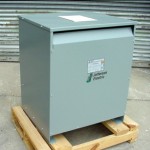PCB and Scrapping Large Kva or Mva Transformers
MIDWEST sells new oil filled large Kva and very large Mva power transformers. But because MIDWEST buys electrical equipment to remanufacture and resell, we get calls from demolition companies and electrical contractors asking what they should do with old oil filled power transformers. They are concerned with the PCB rules regulating oil filled transformers. As an example, MIDWEST had a project to remove the electrical switchgear from a large industrial facility. The demolition company wanted to sell the oil filled transformers in the main outdoor substation right by the building to be torn down. But no legitimate company would take them without the PCB classification certification. The demo company figured the oil recyclers would be happy to buy the old oil and the metal scrap companies would be happy to buy the empty transformers. But they all wanted certification of the PCB classification. The demo contractor asked MIDWEST for some advice, because they were ready to start tearing down the building the next day. Our strong advice was simple. Do not touch the transformers. Do not risk damage to the transformers. Don’t take any chances. And do not trust a “Non PCB” label unless there is documentation of the Non PCB classification and have certification the transformers have not been serviced since that analysis was performed. MIDWEST strongly recommends sampling the transformers by qualified personnel and testing the transformers for PCB and PCB Classification regardless of existing labeling. For decades, oil filled transformers have been labeled Non PCB by manufacturers. Most old transformers have been tested and labeled. The owner should have the documentation or the label should identify the lab that did the analysis. A call to the lab with the location, owner, and serial number may be all that is needed for the lab to ID their analysis. A quick email from the lab should confirm the Non PCB classification and the owner must certify no service has been performed on the oil since the respective analysis. It is very important the demolition company keep a copy of that analysis and certification as Non PCB. If the classification can not be documented, we strongly recommend “do not touch the transformers” until they can be sampled and the Non PCB classification confirmed. Do not move them. Do nothing that has any chance of damaging the transformers and causing a spill. It is not worth it. The seriousness of this is deceiving because the rules for using the transformers are very simple, but the risk is incredible. If anything happens and you spill PCB contaminated oil, the consequences could be disastrous. You may have just gone out of business. Also, oil leakage or weepage from old oil filled power transformers must be properly cleaned up per EPA requirements.
